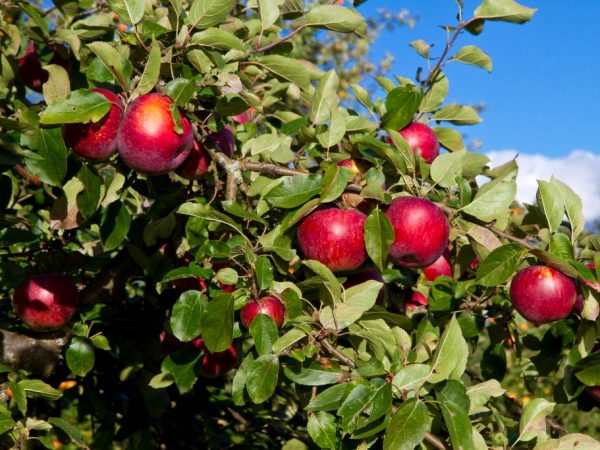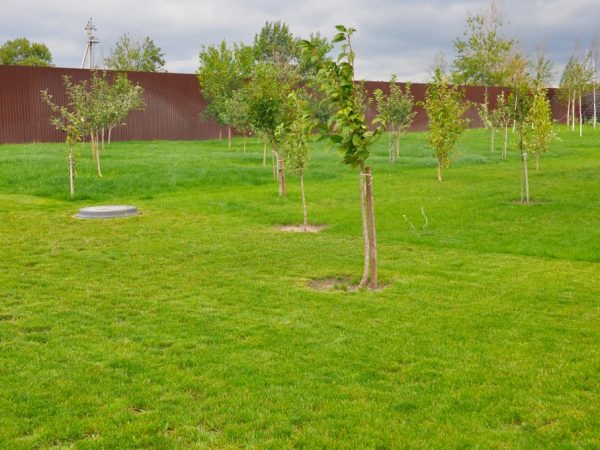Syabryn apple variety
The Belarusian apple-tree of Syabryn is found especially often in its homeland. It was bred in the 80s of the twentieth century with the help of the breeder G. Kovalenko, and is a hybrid crop variety. From her parents, Prima and Loba varieties, she inherited the most positive qualities.

Syabryn apple variety
Characteristics of the variety
Varietal apple trees are considered medium-sized. Their crown is dense, with rich foliage, has a rounded, neat shape.
The Syabryn variety is characterized by certain positive qualities.
- The culture is recognized as fast-growing, therefore, the first harvest after the implementation of the scion (or planting of the seedling) can be obtained already after 3 years.
- Stability of fruiting. When properly cared for, the tree produces a bountiful harvest every year.
- Possesses increased resistance to many diseases, in particular to all types of scab.
- The fruits are characterized by a relatively long shelf life - up to 5 months.
Description of fruits
Apples have an attractive appearance: they are completely crimson-red, without additional inclusions, as if covered with a waxy coating.
The skin is quite dense, the pulp is juicy, fine-grained. The fruit tastes sweet and sour, with proper storage, they are able to maintain their qualities for a long period (up to 5 months).
The tree does not fall off, therefore, during the ripening period, for a longer preservation, it is recommended to pick the fruits yourself.
It is necessary to store the crop in a wooden breathable container, in a cool and ventilated place. Periodically, it should be examined in order to identify among them beaten or damaged.
Growing features
Due to its resistance to cold weather, the Syabryn apple tree can be grown in almost all regions of Europe. Traditional complex care methods are applied to it:
- correct planting of the seedling;
- control over the constant moisture content of the soil around the root area;
- timely implementation of pruning and crown formation;
- if necessary - additional fertilization;
- prevention of diseases and attacks of insect pests.
Landing rules

The tree needs regular watering
Planting a seedling should take place in early spring or late autumn in a prepared and fertilized soil in advance. After planting, it is recommended to immediately prune the branches - this will help form a beautiful crown in the future.
To get a beautiful and rounded shape, it is recommended to prune excess, damaged and dry branches in late autumn (sanitary cleaning), and in early spring, until the first buds awaken.
In the dry season, it is recommended to irrigate regularly without overmoistening the soil. If possible, external irrigation of the apple tree can also be used.
Gardeners recommend thinning out the spring ovaries, of which a lot is formed during the period of active flowering.
If you do not give this due attention, as a result, you will get a crop of chopped, small fruits.
Fertilization of this culture is carried out 3 times a year: in early spring (until the buds swell), during the period of active formation of ovaries and during fruit filling.
Signs of tree disease
Description of the symptoms of culture disease:
- rolling leaves;
- dry, falling off bark on the trunk;
- greens acquire an unusual whitish color;
- ovaries are poorly formed or fall off on their own.
After determining the cause of the malaise (often apple trees get sick due to their infection with nearby fruit trees), you should start treatment with the appropriate disease means.
Gardeners reviews
Despite all the positive characteristics of the apple tree, the Syabryna variety did not acquire the expected popularity. And, although the region of their possible cultivation is large enough, you can not see it in the gardens as often as it deserves.
Gardeners are unanimous in their high resistance to disease. The neat and relatively compact appearance of the plant fits perfectly into the landscape of any summer cottage.
Additional insulation before the onset of cold weather is not necessary. To protect the crop from freezing, it is recommended to mulch the soil around the near-trunk zone in late autumn.

